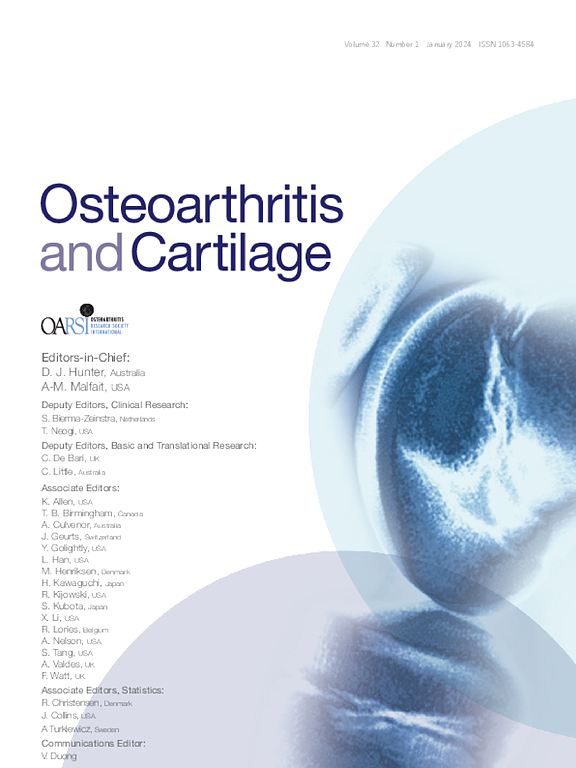Anterior cruciate ligament injury and age affect knee cartilage T2 but not thickness
IF 7.2
2区 医学
Q1 ORTHOPEDICS
引用次数: 0
Abstract
Objective
To investigate the effect of unilateral anterior cruciate ligament (ACL) injury on cartilage thickness and composition, specifically laminar transverse relaxation time (T2) by magnetic resonance imaging (MRI), in younger and older participants and to compare within-person side differences in these parameters between ACL-injured and healthy controls.
Design
Quantitative double-echo steady-state 3 Tesla MRI-sequences were acquired in both knees of 85 participants in four groups: 20–30 years: healthy, HEA20–30, n = 24; ACL-injured, ACL20–30, n = 23; 40–60 years: healthy, HEA40–60, n = 24; ACL-injured, ACL40–60, n = 14 (ACL injury 2–10 years prior to study inclusion). Weight-bearing femorotibial cartilages were manually segmented; cartilage T2 and thickness were computed using custom software. Mean and side differences in subregional cartilage thickness, superficial and deep cartilage T2 were compared within and between groups using non-parametric statistics.
Results
Cartilage thickness did not differ within or between groups. Only the side difference in medial femorotibial cartilage thickness was greater in ACL20–30 than in HEA20–30. Deep zone T2 was longer in the ACL-injured than in the contralateral uninjured knees and than in healthy controls, especially in the lateral compartment. Most ACL-injured participants had side differences in femorotibial deep zone T2 above the threshold derived from controls.
Conclusion
In the ACL-injured knee, early compositional differences in femorotibial cartilage (T2) appear to occur in the deep zone and precede cartilage thickness loss. These results suggest that monitoring laminar T2 after ACL injury may be useful in diagnosing and monitoring early articular cartilage changes.
前十字韧带(ACL)损伤和年龄会影响膝关节软骨 T2,但不会影响厚度。
目的通过磁共振成像(MRI)研究单侧前十字韧带(ACL)损伤对年轻和年长参与者软骨厚度和组成的影响,特别是层状横向弛豫时间(T2),并比较ACL损伤者和健康对照组在这些参数上的人侧内差异:定量双回波稳态(qDESS)3 特斯拉核磁共振成像序列采集了四组 85 名参与者的双膝:20-30 岁:健康,HEA20-30,n=24;前交叉韧带损伤,ACL20-30,n=23;40-60 岁:健康,HEA40-60,n=24;前交叉韧带损伤,ACL40-60,n=14(前交叉韧带损伤在纳入研究前 2-10 年)。负重股胫骨软骨由人工分割,软骨T2和厚度由定制软件计算。使用非参数统计学方法比较组内和组间亚区域软骨厚度、表层和深层软骨T2的平均值和侧差:结果:软骨厚度在组内和组间均无差异。只有 ACL20-30 组的股胫骨内侧软骨厚度侧差大于 HEA20-30 组。前交叉韧带损伤膝关节的深区T2长于对侧未损伤膝关节,也长于健康对照组,尤其是外侧室。大多数前交叉韧带损伤者的股胫骨深区 T2 侧差高于对照组的阈值:在前交叉韧带损伤的膝关节中,股胫骨软骨(T2)的早期成分差异似乎发生在深区,并先于软骨厚度的损失。这些结果表明,在前交叉韧带损伤后监测层状 T2 可能有助于诊断和监测早期关节软骨变化。
本文章由计算机程序翻译,如有差异,请以英文原文为准。
求助全文
约1分钟内获得全文
求助全文
来源期刊

Osteoarthritis and Cartilage
医学-风湿病学
CiteScore
11.70
自引率
7.10%
发文量
802
审稿时长
52 days
期刊介绍:
Osteoarthritis and Cartilage is the official journal of the Osteoarthritis Research Society International.
It is an international, multidisciplinary journal that disseminates information for the many kinds of specialists and practitioners concerned with osteoarthritis.
 求助内容:
求助内容: 应助结果提醒方式:
应助结果提醒方式:


